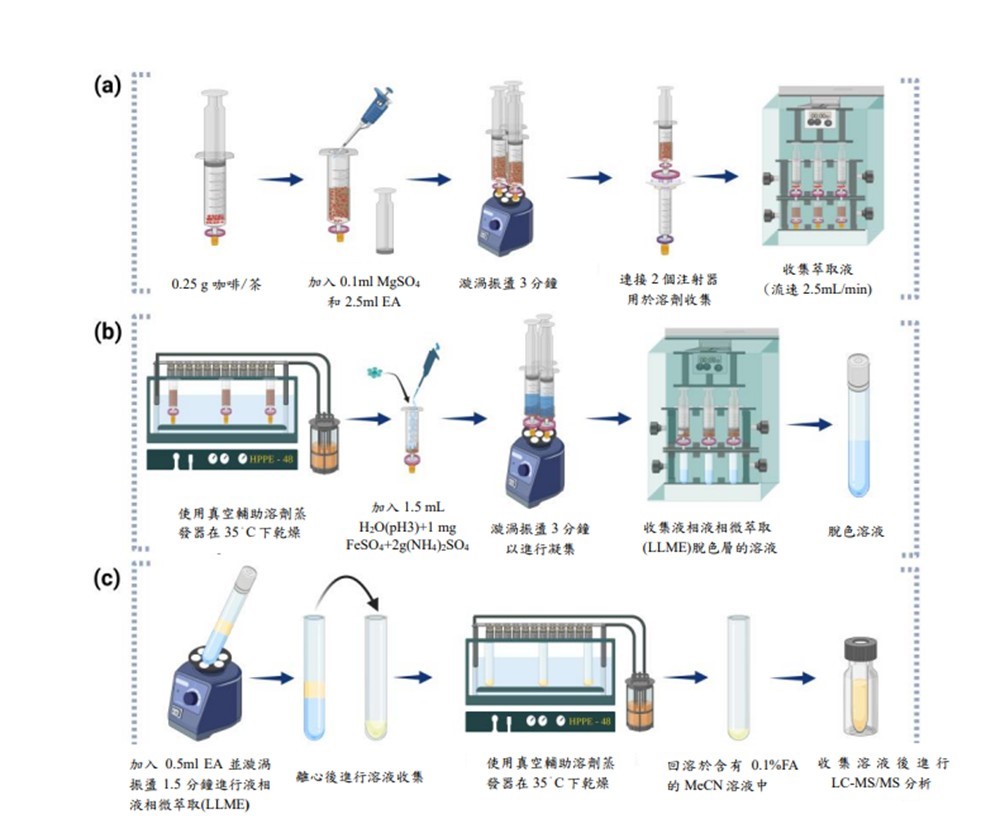新穎半自動注射器內含促凝劑輔助快速黴菌毒素萃取 (FaMEx) 技術結合UHPLC-MS/MS檢測咖啡及茶樣品中的赭麴毒素A
新穎半自動注射器內含促凝劑輔助快速黴菌毒素萃取 (FaMEx) 技術結合UHPLC-MS/MS檢測咖啡及茶樣品中的赭麴毒素A
咖啡中的赭麴毒素A污染可能發生在咖啡生產過程中的不同階段。它可同時存在於咖啡樹及咖啡豆中。不過,它通常與收穫後的處理過程有關,例如乾燥過程、儲存環境或運輸條件的不同有關。 黴菌種類中麴菌屬和青黴屬是咖啡豆中赭麴毒素A 主要產生的原因之一。 國際癌症研究機構 (IARC) 將赭麴毒素A列為可能對人體有致癌性的物質。長期接觸麴毒素A與腎損傷、免疫抑制以及罹患某些類型癌症的潛在風險增加有關。因此,許多國家制訂了嚴格的法規來限制食品(主要是咖啡)中赭麴毒素A的含量。本研究的主要目的是開發一種新技術,用於快速有效地萃取及定量咖啡和茶樣品中的赭麴毒素A。
本研究中使用的方法稱為「半自動注射器內含促凝劑輔助液相-液相微萃取」(IS-CGA-LLME)。 它涉及以下三個步驟萃取過程。 萃取 (I):使用低體積溶劑從咖啡和茶樣品中萃取赭麴毒素A。 淨化(II):對萃取物進行凝集處理以去除雜質。預濃縮(III):將淨化後的萃取物採用液相-液相微萃取對赭麴毒素A進行濃縮。最後,使用超高效能液相層析結合串聯質譜儀對含有赭麴毒素A前處理過的咖啡和茶樣品進行定量。該方法對赭麴毒素A的檢測極限及定量極限分別達到了 0.001 和 0.003 ng g−1 的高靈敏度。該萃取方法表現出出色的回收率(93% 至 111%),且回收率低於 10%,結果表明此萃取方法具有再現性及可靠性。
綜合以上所述,我們首次在食品樣品前處理中導入具有促凝劑的分析樣品前處理技術。此研究的結論為所開發的IS-CGA-LLME 方法是一種低成本、簡單、淺顯易懂的、半自動化和低基質效應的技術,可用於檢測咖啡和茶等食品樣品中的赭麴毒素A。同時,本研究提出了一種有效的萃取及定量咖啡和茶中赭麴毒素A的方法,該方法靈敏度高、回收率好、精密度佳。該技術在食品安全和品質管控方面具有潛在的應用,特別是用於監測咖啡及茶樣品中是否有黴菌毒素的汙染。
圖形摘要

半自動注射器內促凝劑輔助液相-液相微萃取圖示
應用與亮點:
1.一種新穎注射器內含促凝劑輔助微萃取技術的開發。
2.硫酸亞鐵作為促凝劑表現出優異的基質消除能力。
3.該方法採用半自動設置,具有較少樣品及溶劑的消耗量。
4.該方法具有簡單、靈敏度高、基質效應低、高效率的特性。
5.使用LC-MS/MS分析咖啡及茶樣品中的黴菌毒素。
【研究團隊】
團隊成員:Karthikeyan Prakasham, Swapnil Gurrani, 謝建台, 吳明蒼, 吳佳芳, Yu-Chia Lin, Bongee Tsai, 黃柏菁, Gangadhar Andaluri, 庫碼
代表單位:
Department of Medicinal and Applied Chemistry, Kaohsiung Medical University (KMU), Kaohsiung City, Taiwan
Research Centre for Precision Environmental Medicine, Kaohsiung Medical University (KMU), Kaohsiung City, Taiwan
團隊簡介:
綠色奈米分析化學教授Vinoth Kumar 來自高雄醫學大學(KMU)醫藥暨應用化學系與精準環境醫學研究中心。自2016 年以來,在奈米及綠色分析技術領域一直處於主要的領導地位。實驗室團隊專注於人體生物監測項目以及藥物、生物標誌物和生物代謝物的分析及監測。該實驗室是醫藥暨應用化學系的重要組成部分,研究領域多邊聚焦於新型奈米材料、生物質量轉化、生物燃料、樣品前處理、綠色分析化學方法、層析和質譜分析以及應用分析方法的開發並應用於臨床醫學、食品、藥物和環境的分析。
研究聯繫Email:kumar@kmu.edu.tw
論文出處:
Journal- Food Chemistry .Year-2023/08/15Issue (Volume)- 417Pages- 135951
全文下載:
https://doi.org/10.1016/j.foodchem.2023.135951
Ultra-sensitive determination of Ochratoxin A in coffee and tea samples using a novel semi-automated in-syringe-based coagulant-assisted fast mycotoxin extraction (FaMEx) technique coupled with UHPLC-MS/MS
Ultra-sensitive determination of Ochratoxin A in coffee and tea samples using a novel semi-automated in-syringe-based coagulant-assisted fast mycotoxin extraction (FaMEx) technique coupled with UHPLC-MS/MS
Ochratoxin A contamination in coffee can occur at different stages of the coffee production process. It can be present in coffee beans while still on the coffee plant. Still, it's more commonly associated with post-harvest stages, such as improper drying, storage, or transportation conditions. Mold species from the Aspergillus and Penicillium genera are responsible for ochratoxin A production in coffee beans. The International Agency for Research on Cancer (IARC) classifies ochratoxin A as a possible human carcinogen. Chronic exposure to ochratoxin-A has been associated with kidney damage, immunosuppression, and a potentially increased risk of developing certain types of cancers. Therefore, there are strict regulations in place in many countries to limit the levels of ochratoxin A in food products, mainly coffee. The primary objective of this study is to develop a new technique for the fast and efficient extraction and quantification of Ochratoxin A in coffee and tea samples.
The method used in this study is called "semi-automated in-syringe-based coagulant-assisted liquid–liquid microextraction" (IS-CGA-LLME). It involves a three-step extraction process as follows. Extraction (I): Ochratoxin A is extracted from the coffee and tea samples using a low-volume solvent extraction. Clean-up (II): The extract is then subjected to a coagulation process to remove impurities. Pre-concentration (III): The cleaned-up extract is processed using liquid-liquid microextraction to concentrate the ochratoxin A. Finally, the pre-treated coffee and tea samples containing ochratoxin A are quantified using ultra-high-performance liquid chromatography connected with a tandem-mass spectrometer. The method achieved highly sensitive detection and quantification limits of 0.001 and 0.003 ng g−1 for ochratoxin A, respectively. The extraction method demonstrated excellent recovery from 93% to 111% range with less than 10%, which suggests that the results are reproducible and reliable.
In summary, we introduced a coagulation-based analytical sample pre-treatment technique for the first time in food sample pre-treatment. The study concludes that the developed IS-CGA-LLME method is a low-cost, simple, compassionate, semi-automated, and low-matrix effect technique for determining ochratoxin A, specifically ochratoxin A, in food samples such as coffee and tea. Meanwhile, this study presents an efficient method for extracting and quantifying ochratoxin A in coffee and tea, with high sensitivity, good recovery rates, and precision. This technique has potential applications in food safety and quality control, especially for monitoring mycotoxin contamination in coffee and tea samples.
Graphical Abstract:

Graphical representation of the semi-automated in-syringe-based coagulant-assisted liquid–liquid microextraction
Highlights:
1.A novel in-syringe-based coagulant-assisted microextraction technique was developed.
2.Ferrous sulfate, as a coagulation agent exhibited excellent matrix elimination.
3.This method utilizes semi-automated setups with minimal sample and solvent amounts.
4.This protocol is a simple, highly sensitive, low-matrix effect and efficient procedure.
5.Applied for analyzing mycotoxin in coffee and tea samples using LC-MS/MS.
Research Team Members:
Karthikeyan Prakasham, Swapnil Gurrani, Jentaie Shiea, Ming-Tsang Wu, Chia-Fang Wu, Yu-Chia Lin, Bongee Tsai, Po-Chin Huang, Gangadhar Andaluri, Vinoth Kumar Ponnusamy
Representative Department:
Department of Medicinal and Applied Chemistry, Kaohsiung Medical University (KMU), Kaohsiung City, Taiwan
Ph.D. Program in Environmental and Occupational Medicine and Research Centre for Precision Environmental Medicine, Kaohsiung Medical University (KMU), Kaohsiung City, Taiwan
Introduction of Research Team:
Nano Green Analytical Chemistry of Professor. Vinoth Kumar hails from the Research Centre of Precision Environmental Medicine, at Kaohsiung Medical University (KMU), Taiwan. It has been leading the Nano and Green Analytical Technology spectrum since 2016. The lab focuses on human biomonitoring projects, monitoring/analyzing drugs, biomarkers, and biometabolites. The lab is a vital part of the Department of Medicinal and Applied Chemistry, where the research is multilaterally focused on novel nanomaterials, biomass conversion, biofuels, sample preparations, green analytical methodologies, chromatographic and mass spectrometric analysis, and analytical method developments with application towards clinical, food, drugs, and environmental research.
Contact Email: kumar@kmu.edu.tw
Publication: Journal- Food Chemistry. Year-2023 Month-August; Issue-147: Pages 135951.
Full-Text Article: https://doi.org/10.1016/j.foodchem.2023.135951


